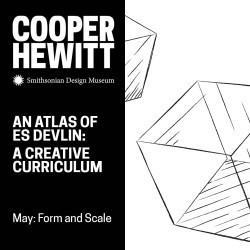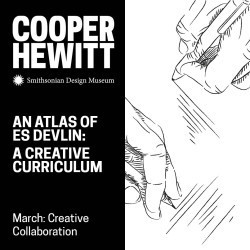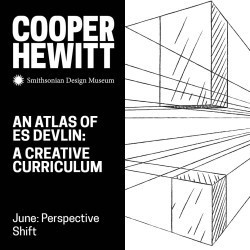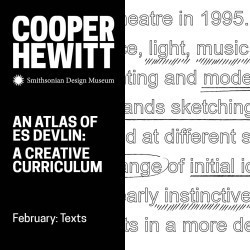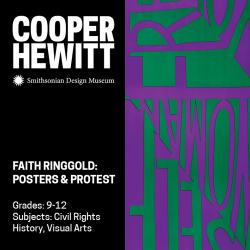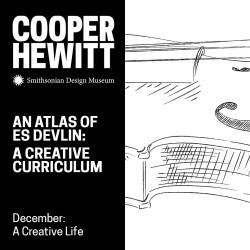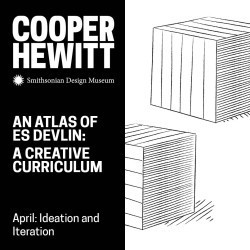Cooper Hewitt Education Department's collections
May: Form & Scale
<p><a href="https://www.cooperhewitt.org/may-form-and-scale/">MAY: FORM & SCALE</a></p>
<p>Es Devlin often works with a limited vocabulary of forms. Basic shapes such as cubes, spheres, triangles, and ellipses evolve into her complex stage designs and stadium sculptures. On stage, she makes these familiar shapes behave in new ways, often transforming them through light, projection, and movement to support a story. The scale of her sculptures also changes how they appear to and effect an audience. A small cube packed with actors might seem fragile and about to break open, while a giant cube framing a pop artist might seem powerful and strong. </p>
<p>As we move through the world, we often look for and respond to forms and scale without thinking about it. We see basic shapes in the patterns of flowers or the forms of buildings, and we feel like we take up more space in a crowded elevator than we might while stretched out in an open park. The exercises and materials on this page will prompt you to think more mindfully about form and scale, allowing you to play with these basic elements as tools in your own creative practice.</p>
 Cooper Hewitt Education Department
Cooper Hewitt Education Department
2
March: Creative Collaboration
<p><a href="https://www.cooperhewitt.org/march-creative-collaboration/"></a><a href="https://www.cooperhewitt.org/march-creative-collaboration/">MARCH: CREATIVE COLLABORATION | Cooper Hewitt, Smithsonian Design Museum</a><a href="https://www.cooperhewitt.org/march-creative-collaboration/"></a></p>
<p><strong>Age: Middle School, Highschool</strong> </p>
<p>Collaboration is essential to Es Devlin’s artistic practice. Directors, studio associates, lighting designers, production managers, musicians, video designers, writers, fabricators, and more enrich her work and make it possible at such a grand scale. Some collaborations might last a few months while others endure for many years. All of them unfold over a continued conversation. No one person always has the best idea, and exchanging ideas fosters stronger outcomes. </p>
<p>While Devlin’s collaborations often have an end goal, much of the richness of working with others comes from the places you explore together along the way—the dead ends, the abandoned ideas, the miscommunications, the fresh starts. Working with someone offers a chance to consider new ways of thinking, and that exchange can inspire new directions for creative work. The exercises and materials on this page offer some ways to kickstart or reflect on collaboration in your own life. What might you learn from one collaboration that you apply to the next? </p>
 Cooper Hewitt Education Department
Cooper Hewitt Education Department
2
June: Perspective Shift
<p><a href="https://www.cooperhewitt.org/june-perspective-shift/">JUNE: PERSPECTIVE SHIFT </a></p>
<p>Es Devlin’s public installations often transform viewers into active participants. She believes that part of her role as an artist is to create transformative experiences between audiences and artwork. Several of her sculptural installations address complex issues such as endangered species or languages. In these works, she uses visuals, sound, and performance to deepen how an audience understands and experiences a story. She hopes that these experiences shift audience perspectives and strengthen their connections to each other and to the planet. </p>
<p>In our own creative practices, shifting perspectives can open new ways into thinking about the world and how we experience it. The neighborhoods we live in might feel less familiar if we try to imagine them from the perspective of a pigeon or even a tulip in full bloom. The exercises and materials on this page invite you to explore some new perspectives to foster creative thinking. </p>
 Cooper Hewitt Education Department
Cooper Hewitt Education Department
2
Faith Ringgold: Posters & Protest
<p>Analyze political posters designed by artist, author, and activist Faith Ringgold, and design your own protest poster about a civil rights issue today.</p>
<p>Grades:9-12</p>
<p>Subjects: Civil Rights History, Visual Arts</p>
 Cooper Hewitt Education Department
Cooper Hewitt Education Department
1
December: A Creative Life
<p><a href="https://www.cooperhewitt.org/december-a-creative-life/">DECEMBER: A CREATIVE LIFE | Cooper Hewitt, Smithsonian Design Museum</a></p>
<p>Devlin’s creative life began in childhood. Like many of us, she made things to entertain herself. She built dioramas and staged plays with her siblings, holding candy wrappers against a projector’s light in order to wash the room in different colors. She both studied and created art. An avid reader, she loved to mark in her books. She also learned to play the piano, violin, and clarinet. During visits to museums, she explored exhibitions that introduced her to new types of sculpture and installation, some of which inspired her artwork for many years to come. Over 30 years, she’s expanded and adapted her craft while nurturing a thriving studio space.</p>
<p>While Devlin models one version of an artistic life, all of us make creative choices every day. Our favorite movies, meals, books, and music reflect how we see ourselves and the world around us. Even the ways we build relationships and share experiences reflect our creativity. Connecting with our creativity sometimes requires us to change our routines in order to open new space for reflection or action. The prompts, exercises, and programs on this page provide some ways to spark and develop creative thinking.<br><br></p>
 Cooper Hewitt Education Department
Cooper Hewitt Education Department
2
April: Ideation & Iteration
<p><a href="https://www.cooperhewitt.org/april-ideation-iteration/">APRIL: IDEATION & ITERATION | Cooper Hewitt, Smithsonian Design Museum</a></p>
<p>Age: Middle School, High school </p>
<p>Es Devlin begins each project with a blank sheet of paper, often sketching in response to a song lyric or a line from a poem. She informs her ideas by devouring books, theater, art, music, and poetry—the work of others is a great influence. As she shares, “An idea is only ever part of a continuum of thought.” She iterates to explore, refine, and tweak ideas. Revisions clarify an idea or respond to collaborator feedback. The final forms of Devlin’s work, whether for a performance or installation, are held up by the rigor of constant ideating and iterating. </p>
<p>Sometimes it may feel daunting to approach a blank page. Yet ideas can germinate anywhere—from books you read; in others’ creative practices; from walking in nature. Iterating on an idea allows you to further open to possibility. What new ideas might be elicited by revisiting something from a different vantage point? How can tweaking an approach or idea help to refine it? The exercises and materials on this page encourage you to explore different ways to ideate and iterate in your own life.</p>
 Cooper Hewitt Education Department
Cooper Hewitt Education Department
2

